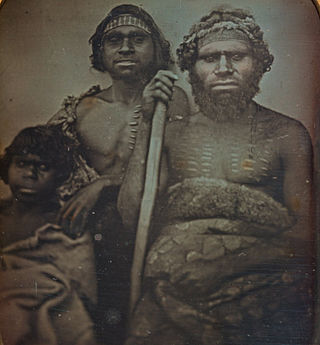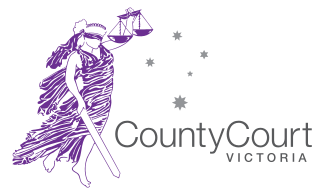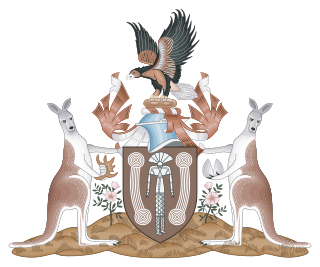Related Research Articles

Koori is a demonym for Aboriginal Australians from a region that approximately corresponds to southern New South Wales and Victoria. The word derives from the Indigenous language Awabakal. For some people and groups, it has been described as a reclaiming of Indigenous language and culture, as opposed to relying on European titles such as "Aboriginal". The term is also used with reference to institutions involving Koori communities and individuals, such as the Koori Court, Koori Radio and Koori Knockout.
A Koori Court is a separate division of the Magistrates', County and Children's Courts of Victoria, Australia. The Koori Court (Magistrates), Children's Koori Court, and County Koori Court hear selected cases, where Indigenous Australians have identified as such and requested the case be transferred to it. The first Koori Court was established in Shepparton in 2002. Koori Court aims to reduce recidivism by involving Elders, other respected persons in the Aboriginal community, and court advisors to provide information about the background of the defendant, and to advise on culturally appropriate sentences.

The County Court of Victoria is the intermediate court in the Australian state of Victoria. It is equivalent to district courts in the other states.

The Magistrates Court of South Australia is the lowest level court in the state of South Australia. The Magistrates Court, then known as the Court of Petty Sessions, was established in 1837, by the Court of Sessions Act 1837. It has both original and appellate jurisdiction and hears matters specified in the Magistrates Court Act 1991 (SA).
The Bureau of Crime Statistics and Research (BOCSAR), also known as NSW Bureau of Crime Statistics and Research, is an agency of the Department of Communities and Justice responsible for research into crime and criminal justice and evaluation of the initiatives designed to reduce crime and reoffending in the state of New South Wales, Australia.
The Youth Justice Court of the Northern Territory is an Australian court which hears and determines cases concerning crimes committed by children under the age of 18 years in the Northern Territory.

The Local Court of the Northern Territory is one of two levels of court in the Northern Territory of Australia. It has jurisdiction in civil disputes up to A$250,000, and in criminal cases in the trial of summary offences, and also deals with preliminary matters for indictable offences which are then heard by the Supreme Court of the Northern Territory. There are local courts held in Darwin, Northern Territory, Alice Springs, Katherine, Tennant Creek, and some "bush courts" in remote locations.
In several countries including Australia, the United States, the United Kingdom, Canada, and South Africa, a community court is a neighborhood-focused problem-solving court that applies a problem-solving approach to local crime and safety concerns. Community courts can take many forms, but all strive to create new relationships, both within the justice system and with outside stakeholders such as residents, merchants, churches and schools. Community courts emphasize collaboration, crime prevention, and improved outcomes, including lower recidivism and safer communities. Community courts are also sometimes referred to as community or neighborhood justice centers.
The New South Wales Sentencing Council is an advisory body established by the New South Wales Government to provide guidelines and to promote consistency in sentencing of offenders in New South Wales, a state of Australia. The council provides advice and counsel to the Attorney General of New South Wales on issues relating to sentencing, parole periods for sentences, trends, and the operation of parole. The council aims to promote consistency and transparency in sentencing and promoting public understanding of the sentencing process. The Sentencing Council consists of members appointed by the attorney general. Those members are made up from a diverse background to better represent the views of the community. They include retired judges, law enforcement officers, defence lawyers, indigenous community members and persons associated with victims of crime.
A diversion program, also known as a pretrial diversion program or pretrial intervention program, in the criminal justice system is a form of pretrial sentencing that helps remedy behavior leading to the arrest. Administered by the judicial or law enforcement systems, they often allow the offender to avoid conviction and include a rehabilitation program to prevent future criminal acts. Availability and the operation of such systems differ in different countries.
Ian L. Gray AM is a retired Victorian lawyer, and former judge, chief magistrate and State Coroner at the Coroners Court of Victoria.
The Children's Court of Victoria is a statutory court created in Victoria, Australia. The court deals with criminal offences alleged to be committed by children aged between 10 and 17 and with proceedings concerning children under the age of 17 relating to the care and protection of children.
Indigenous Australians are both convicted of crimes and imprisoned at a disproportionately higher rate in Australia, as well as being over-represented as victims of crime. As of September 2019, Aboriginal and Torres Strait Islander prisoners represented 28% of the total adult prisoner population, while accounting for 2% of the general adult population. Various explanations have been given for this over-representation, both historical and more recent. Federal and state governments and Indigenous groups have responded with various analyses, programs and measures.

The judiciary of New Zealand is responsible for the system of courts that interprets and applies the laws of New Zealand. It has four primary functions: to provide a mechanism for dispute resolution; to deliver authoritative rulings on the meaning and application of legislation; to develop case law; and to uphold the rule of law, personal liberty and human rights. The judiciary is supported in its work by an executive department, the Ministry of Justice.
The Youth Koori Court (YKC) is a court tailored to the needs of Aboriginal and Torres Strait Islander children and young people who engage with the criminal justice system in the state of New South Wales, Australia. It operates out of the Children's Court of New South Wales. The first such court was established in the western Sydney suburb of Parramatta in 2015, with another created in Surry Hills to serve the city of Sydney in early 2019, and the first regional YKC established in Dubbo in 2022. The YKC involves older members of the Aboriginal community to help the youths to engage with their culture, among other measures.
In the Australian legal system, a good behaviour bond is a type of non-custodial sentence which involves the condition of the offender's “good behaviour” for a set period. The condition of “good behaviour” primarily requires the offender to obey the law, but may also include additional probation officer supervision, mandatory medical treatment or participation in rehabilitation, counselling and intervention programs. These imposed conditions are determined by state legislation and at the magistrate's discretion. A good behaviour bond may be established with or without a recorded legal conviction for the offence. The specific conditions which constitute a good behaviour bond, as well as the consequences for breaching them, vary under each Australian state or territory's legislation, but overall are used most commonly for first-time and juvenile offenders.
Criminal sentencing in Canada is governed by the Canadian Criminal Code. The Criminal Code, along with the Supreme Court of Canada, have distinguished the treatment of Indigenous individuals within the Canadian Criminal Sentencing Regime.
Murri Courts are a type of specialist community court for sentencing Aboriginal and Torres Strait Islander people in Queensland, Australia. The first Murri Court was established in Brisbane in August 2002, with more being established throughout the state over the next 10 years, catering for both adult and young offenders, under the Magistrates and Children's Court networks. After being closed down by the government in September 2012 as a cost-cutting exercise, they were reopened in April 2016 under the new Palaszczuk government. As of July 2022 there are Murri Courts in 15 locations throughout Queensland.
The Nunga Court, also known as Aboriginal Sentencing Court, is a type of specialist community court for sentencing Aboriginal people in South Australia. Such courts exist at several locations throughout the state, as a sentencing option for eligible Aboriginal and Torres Strait Islander offenders who plead guilty of an offence.
An Indigenous court, also known as Aboriginal court, First Nations court, and other locally relevant terms, usually refers to specialist sentencing courts or modified court procedures for offenders who are Indigenous peoples of a colonised country. They include:
References
- 1 2 "Aboriginal Community Court". Department of the Attorney-General (WA). Archived from the original on 29 August 2007.
{{cite web}}: CS1 maint: unfit URL (link) - 1 2 3 4 Law Reform Commission of Western Australia (December 2005). Aboriginal Customary Laws (PDF). Project 94: Discussion Paper. State Solicitor's Office. pp. 144–147. ISBN 1-74035-053-7 . Retrieved 25 July 2022.
- ↑ Martin, Wayne (5–7 October 2007). "Customary Law – Western Australia" (PDF). Presented at the Judicial Conference of Australia (JCA) Colloquium in Sydney. Archived from the original (PDF) on 20 July 2008. Retrieved 15 January 2008.
- ↑ "Aboriginal Courts in Western Australia". Australian Law Reform Commission . 18 August 2010. Retrieved 24 July 2022.
- ↑ "Recognition of Aboriginal Customary Laws". Australian Law Reform Commission . ALRC Report 31. 11 June 1986. Retrieved 24 July 2022.
- 1 2 Martin, Wayne (8 December 2006). "Leadership Western Australia Graduation Dinner [speech]" (PDF). Archived from the original (PDF) on 29 August 2007. Retrieved 15 January 2008.
- 1 2 3 "First Nations Specialist Courts" (PDF). Briefing Paper. Law Society of Western Australia. August 2021. Retrieved 24 July 2022.
- 1 2 Aboriginal Legal Service of Western Australia (June 2009). Submission to the WA Attorney-General: Aboriginal Community Courts: Kalgoorlie and Norseman (PDF) (Report). Includes a letter to Christian Porter, then WA Attorney-General. Retrieved 24 July 2022.
- ↑ The West Australian (13 August 2015). "Aboriginal court gets the chop". The West Australian. Retrieved 24 July 2022.
- ↑ "MP accuses WA Govt of backing Indigenous violence, ABC News, 29 June 2006
- ↑ Aboriginal Community Court Archived August 29, 2007, at the Wayback Machine
- ↑ Same Crime, Same Time: Sentencing of Federal Offenders (Report). ALRC Report 103. Australian Law Reform Commission. 2006. ISBN 0-9758213-3-4. Archived from the original on 16 August 2006.